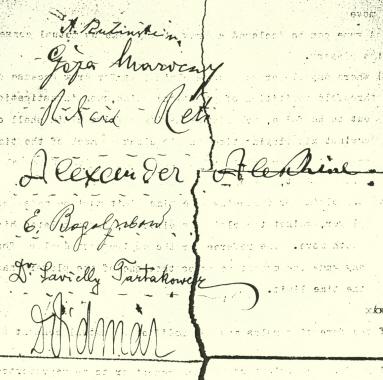
Edward Winter

Signatures on the London Rules (1922)
This feature article focuses on the conditions for the 1927 world title match, and particularly on whether they contained a 5-5 clause.
Several times in Garry Kasparov on My Great Predecessors Part I it is stated that if a 5-5 score had been reached in the 1927 world championship match between Capablanca and Alekhine the contest would have been drawn. Scepticism about this has been expressed, and Kasparov has acknowledged (in his interview with Hanon Russell at the Chess Café) that the claim may be unfounded. Here we provide an overview of the issue.
The Buenos Aires match was the only one played under the London Rules, which had been agreed upon on 9 August 1922 by Capablanca, Alekhine, Bogoljubow, Maróczy, Réti, Rubinstein, Tartakower and Vidmar. They were published on pages 133-134 of the November 1926 American Chess Bulletin and pages 125-126 of the January 1927 Chess Amateur. We believe that the first book to reproduce the full text was our 1989 volume on Capablanca.
Clause one of the London Rules stated:
‘The match to be one of six games up, drawn games not to count.’
That plain wording, coupled with the absence of any reference to a 5-5 condition elsewhere in the Rules, might suggest a quick end to the matter, but there are complications. We first discussed a possible 5-5 condition 18 years ago (C.N. 880), when the late Božidar Kažić of Belgrade informed us that during the 1978 Karpov-Korchnoi match in Baguio Max Euwe had told him regarding the 1927 event: ‘It is not true about 5-5; it is the imagination of journalists.’
The previous year (i.e. 1984 – C.N. 728) we had quoted a letter written by Capablanca to Julius Finn from Buenos Aires on 15 October 1927 which concluded:
‘Should the match here end in a draw, I suggest that the next match be limited to 20 games, the winner of the majority to win the match. Please attend to this for me.’
The complete text is given on page 203 of our Capablanca book, together with an extract from a similar letter which the Cuban wrote the same day to Norbert Lederer:
‘You have no doubt kept track of the match and have seen that no matter what the final result it is evident that another match should be played. I have spoken to Alekhine, who agrees with me. … If this match [i.e. the 1927 one] should end in a draw it might be advisable to limit the number of games to 20, the winner of the majority to win the match. If someone should win, then perhaps we might keep the same rules.’
An apparent contradiction between the two above-mentioned items (C.N.s 728 and 880) suddenly dawned on us in 1988, prompting us to comment in C.N. 1775:
‘… When the winner of an unlimited match is the first player to win six games, it is mathematically impossible for the outcome to be drawn. There would thus seem to be three possibilities:
a) Capablanca’s remark to Finn was careless;
b) Capablanca was thinking of possible future deadlock in which he and Alekhine might agree to abandon the match as a draw;
c) Capablanca and Alekhine had a prior agreement that if the match reached 5-5 it would be drawn.
Possibility c) would appear unlikely owing to the lack of documentary evidence – notably in the London Rules, which made no reference to a drawn match or a 5-5 condition. However, Clause 21 reads: “Any of the foregoing rules may be modified by mutual consent between the players and the contributors to the purse, or the referee in case of inability of the contributors to be present or to be represented, but such modifications shall in no way establish a precedent in future cases.”
It will be recalled that Capablanca wrote to Finn on 15 October 1927. The score stood at 3-2 in Alekhine’s favour, the games played on 13, 14 and 15 October all being short draws. Between 13 October and 21 November the result was one win each and 17 draws. Capablanca’s victory on 15 November reduced Alekhine’s lead to 4-3, so the 5-5 question could have become significant.’
Occasional claims of a 5-5 clause continued to appear and to be challenged. For instance, on page 8 of the 4/2000 New in Chess a reader, Claus van de Vlierd, asked Genna Sosonko ‘on the basis of what document he assumes that a 5-5 draw would have been sufficient for Capablanca to retain “his” title’. Sosonko replied:
‘I have to admit that I took this erroneous information from a book by the Russian chess historian Isaac Linder. As you indicate there is no mention of this clause in the London Rules.’
The question asked by Claus van de Vlierd about documentary evidence was certainly the right one. In particular, it may be wondered when the 5-5 condition first appeared on paper. The earliest occurrence we have found so far is on pages 47-48 of Kapablanka by Vassily Panov (Moscow, 1959), and we shall be pleased to hear from any reader who can help us trace it back further.
(3013)
C.N.s 406 and 728 discussed the letter sent by Capablanca to Julius Finn during the 1927 world championship match (in which his mind was already on a return contest in 1929). In C.N. 406 R.D. Picken (Greasby, England) observed that ‘it even appeared in the 1928 BCM. How on earth did such a letter come to be released to the public?’ Well, we still don’t know that, but one clarification is possible: the letter even became public during the match. This is shown by La Prensa (Buenos Aires) of 30 September 1927:
‘It having been made public that during the match Capablanca wrote a letter to leading members of the New York Chess Club suggesting that arrangements should be made for a return match in 1929, which Capablanca himself has confirmed to us, we questioned the new champion about the matter.
Dr Alekhine declared that he would have great pleasure in playing a return match with Capablanca in 1929, provided that Capablanca submitted an official challenge in accordance with the London Rules.
“Naturally”, added Dr Alekhine, “this new contest will have to take place under the same conditions as the present one; since I won the title by playing more than 30 games it would be illogical for me to be able to lose it by one point in a match limited to, for instance, 20 games.
If I were to be challenged by Capablanca and by other masters at the same time, I would give preference to Capablanca, but on the sole condition that the match is not played in Havana, on account of the climate. I should be very happy to play in, for example, the United States.”
If challenged by other masters, the new champion will be able to limit the number of games to be played.’
The newspaper has a photograph of Alekhine in the playing room, the position at the board being the final one of the match (after 82 Re7 in game 34).
(1373)
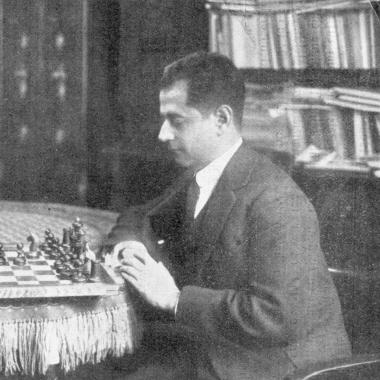
José Raúl Capablanca
No pre-1959 reference has yet been traced concerning a possible 5-5 condition in the 1927 world championship match. One passage that we have found (without being sure whether it is a clue or a red herring) is a contemporary reference to Clause 21 of the London Rules in connection with the unlimited duration of the Buenos Aires match. The item was a reply to a subscriber on page 208 of the November 1927 issue of the Uruguayan chess magazine Mundial:
‘Un suscriptor. El match por el Campeonato del mundo es a seis partidas ganadas y se proclamará vencedor el que alcance en primer término ese número de victorias. La cantidad de partidas a jugarse no tiene límite y por lo tanto tiene Vd. razón al manifestar que el match puede durar varios meses. Esto en cuanto a la teoría, pues prácticamente no ha de producirse eso. Sin embargo, debe tenerse en cuenta el artículo 21 de las bases, que dice lo siguiente: “Cualquiera de estas bases podrá ser modificada por consentimiento de ambos jugadores y de los contribuyentes a la bolsa, o el ‘referee’ en caso de la imposibilidad de dichos contribuyentes de hallarse presentes o representados, pero tales modificaciones no establecerán un precedente para el futuro”.’
(3026)
Concerning the unresolved issue of whether a 5-5 clause was in force for the 1927 world championship match, C.N. 3013 reported that the earliest such claim we had found was on pages 47-48 of Kapablanka by Vassily Panov (Moscow, 1959). However, Louis Blair (Carlinville, IL, USA) now informs us that at Kasparov’s new ‘Chesschamps.com’ website a contributor, Tapio Huuhka, has pointed out an earlier occurrence, in Max Euwe’s book Meet the Masters. This find is of much interest and prompts us to make a number of observations.
Meet the Masters, an English edition of Zóó schaken zij! (Amsterdam, 1938), was translated by L. Prins and B.H. Wood and published by Pitman, London in 1940. A second edition from the same publisher came out in 1945 (slightly updated by Wood, who stated on page vi that he was ‘cut off, as a result of the war, from both the author and my co-translator’). In both editions the relevant passage, regarding the 34th and last match game, is on page 55 and reads:
‘When this game began, Alekhine had a margin of two games (5-3) in his favour, but not everybody backed him to win even then. According to the conditions of the match, Capablanca required to win only two games to achieve an even score (5-5) and remain champion. It was at this critical stage of the match that Alekhine won game and title.’
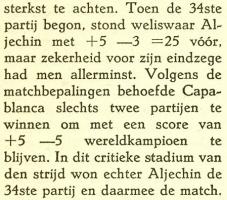
From page 32 of the 1938 book Zóó schaken zij! by Max Euwe
This statement (made, let it be noted, when Alekhine and Capablanca were still alive) is of evident importance because of the stature of Euwe, a former world champion who had frequently conversed with both Alekhine and Capablanca in the 1930s about world title match conditions. There are, though, complications to be examined.
During a discussion about ghost-writing Lodewijk Prins informed us, in a letter dated 13 January 1988 (see pages 182-183 of Chess Explorations), that Hans Kmoch had worked on Meet the Masters as an unnamed ‘expert assistant’. This raises the question of whether the 5-5 statement did indeed originate with Euwe. On the other hand, Kmoch himself was also well acquainted with both Alekhine and Capablanca. Indeed, in his article ‘My Personal Recollections of Capablanca’ on pages 362-363 of Chess Review, December 1967 he wrote:
‘In Kissingen [1928], my contact with Capablanca became rather close. We had long walks together, usually talking about the world championship in reference to which Capablanca always used the expression “my title”, making it seem that the title had only incidentally and temporarily strayed to Alekhine. More than once he explained to me how I could make a lot of money. Very simple: just organize the return match against Alekhine and bet as much as possible on me; you will win, that much is absolutely sure.’
Another book which discussed the closing stages of the 1927 world championship match was Het Schaakphenomeen José Raoul Capablanca by M. Euwe and L. Prins (The Hague, 1949), but the chapter on the contest (pages 153-173) made no mention of any 5-5 clause. Although that section was labeled as having been written by Euwe, doubts subsist, for in a letter to us dated 22 October 1987 Prins referred to “my” Capablanca book (I did most of the work including literary and analytic research)’.
Since it is impossible to determine exactly what Euwe himself did or did not write in the various books bearing his name (or to know the extent to which he verified his helpers’ input/output), further investigation of the 5-5 affair will, we suggest, need to cover the writings on the 1927 match of all three of them, i.e. Euwe, Kmoch and Prins.
We finish for now with the most peculiar aspect of this new ‘Euwe twist’. As noted in C.N. 3013, the possibility of a 5-5 condition was first discussed in C.N. after the late Božidar Kažić of Belgrade had informed us, in a letter dated 14 October 1984, that during the 1978 Karpov-Korchnoi match in Baguio he had been told regarding the 1927 match, ‘It is not true about 5-5; it is the imagination of journalists’. The person who made that statement to Kažić was Max Euwe.
(3326)
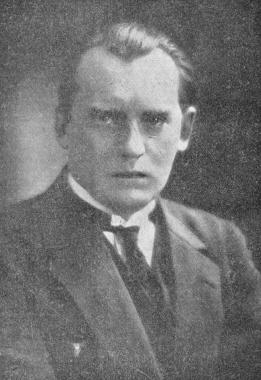
Alexander Alekhine
Niall Murphy (Galway, Ireland) enquires about the financial conditions for the 1927 world championship match.
According to page 66 of Ajedrez Americano, December 1927, the total cost to the organizers, the Club Argentino de Ajedrez in Buenos Aires, was nearly 40,000 pesos. As indicated in such sources as page 454 of the October 1926 BCM (a report by P.W. Sergeant), the Club offered a purse of $10,000 (roughly £2,000). It may be recalled that Clause 9 of the London Rules stated: ‘Of the total amount of the purse the champion shall receive 20% as a fee. Of the remaining 80% the winner to receive 60% and the loser 40%.’ Christian Sánchez (Rosario, Argentina) points out that this division is confirmed by the following paragraph from La Prensa, 14 September 1927, i.e. the day after a meeting between Capablanca, Alekhine and the organizing committee:
‘Las condiciones finales para el encuentro quedaron fijadas ayer en una reunión de la comisión directiva y en presencia de Capablanca y Alekhine. Referente a la bolsa, se han tenido en cuenta las condiciones aprobadas por el torneo de Londres. Es de 10.000 dólares, correspondiendo el 20% de premio al campeón. El 80% restante será dividido en la siguiente forma: 60% al ganador y 40% al perdedor.’
We are grateful to Mr Sánchez for scouring the Argentine press for further information, and particularly about the unresolved issue of whether the match would have been drawn if the score had reached 5-5. In the presentation below we provide English translations of the key passages from the various newspaper reports found by Mr Sánchez, and our own remarks are in square brackets. Mr Sánchez’s commentary is in italics.
“Dice Capablanca: ‘El reglamento del match será a seis partidas ganadas sin limitación de las a jugarse.’ Esto dio motivo a que se hiciera alusión a la interminable cantidad de partidas tablas que tuvieron lugar en su match contra Marshall, en el cual demostró visible superioridad sobre el campeón norteamericano.
Hábil para eludir las cuestiones sobre las que no desea responder Capablanca tuvo una ocurrencia muy graciosa que fue festejada por los contertulios. ‘Si la suerte quiere’ dijo, ‘que obtenga rápidamente cinco juegos ganados contra mi fuerte adversario, no os extrañéis que haya después muchas partidas tablas, pues vuestra ciudad me agrada mucho y me placería prolongar la estada.’
El campeón afirma que Alekhine es el adversario más calificado que pudo oponérsele y manifestó que, a su juicio, era aventurada la opinión de que obtendrá un fácil triunfo pues lo sabe a su rival muy fuerte y está convencido de que la lucha será digna del título ajedrecístico.”
[The report quotes Capablanca as stating, ‘The rules for this match will be six games up without any limit on the number to be played’. A reference having been made to the long series of draws in his 1909 match with Marshall, the Cuban, who was regarded by the newspaper as skilful in avoiding questions he did not wish to answer, offered a rejoinder that was much appreciated: ‘If fate wishes me to obtain quickly five wins against my strong opponent, do not be surprised if afterwards there are many drawn games, since your city pleases me greatly and I should enjoy extending my stay.’ Capablanca added that Alekhine was the best qualified opponent and he discounted the view that he could expect an easy victory, given his opponent’s strength. Capablanca also believed that the battle would be worthy of the world chess title.]
‘In contrast, page 24 of La Prensa of the same day (1 September 1927) had shown that, with Alekhine’s arrival in Buenos Aires still awaited, there was considerable confusion over the terms of the match:
“Las condiciones finales [del match] quedarán fijadas una vez que el dr. Alekhine llegue a esta capital, en una conferencia con Capablanca y las autoridades del club organizador.
Posiblemente, las partidas, en número de 20, se jugarán por la noche, pero es seguro que se disputarán todos los días con uno de descanso en la semana. Las partidas suspendidas continuarán al día siguiente.”
On 7 September 1927, however, La Prensa indicated that the conditions were clear: six wins, draws not counting, and an unlimited number of games:
“El dr. Alekhine opondrá sin duda una espléndida defensa, y no será tarea fácil para Capablanca obtener las seis partidas que se necesitan para proclamarse vencedor. Las tablas no se contarán, y se jugará un número ilimitado de partidas.”
[It is now time to turn to Capablanca’s correspondence discussed in C.N. 3013, i.e. his messages to Julius Finn and Norbert Lederer dated 15 October 1927 (when the match stood at +3 -2 in Alekhine’s favour) in which he asked them to help set up a second match against Alekhine, in 1929, and proposed that if the Buenos Aires match were drawn the second match could be limited to 20 games. The question that we raised is how the Buenos Aires match could, under any circumstances, be drawn if the winner was simply to be the first to win six games. For instance, was there, as some authors (Kasparov, most notably) have asserted, without supplying any corroboration, a condition stating that the match would be drawn if the score became 5-5?]
‘The newspapers consulted contain no reference to any 5-5 clause. There is, moreover, incidental information which runs counter to such a possibility. An example is the following statement in La Prensa of 29 October 1927 that if Alekhine won the 22nd game he would score his fifth victory and the battle would virtually be decided:
“El desenlace [de la partida 22] es esperado con extraordinario interés, pues ganando Alekhine, éste se anotaría el quinto triunfo del match y la lucha por el campeonato quedaría virtualmente decidida.”
I also looked for any reference to the possibility of the match being, under any circumtances, a draw (“empate” in Spanish), particularly after the statements that Capablanca had written to New York became known in Buenos Aires. His words were reported in the 12 November 1927 editions of La Capital (Rosario), La Nación and La Prensa. Naturally he was then asked about the matter, and the following appeared in La Capital on 14 November 1927:
“Cap. Fed., 13: Dice Capablanca que efectivamente cablegrafió al Club de Ajedrez de Nueva York para que organice otro match con Alekhine, sea cual fuere el resultado del que está en disputa.
Confía en que el actual encuentro resulte en un empate, pues espera mejorar su juego y desea un nuevo encuentro porque no está jugando como debería hacerlo.”
[English translation: ‘Capablanca says that he did indeed wire the chess club in New York so that another match with Alekhine could be organized, whatever the outcome of the one now being played. He hopes that the present encounter will be a draw because his hope is to improve his play and he desires a new encounter because he is not playing as he should.’]
‘So Capablanca said that the Buenos Aires match might end in a draw. Or did he? Did he actually use the word “empate” in Buenos Aires? The final sentence of the above report may merely be a journalist’s repetition of the text written by Capablanca to New York. I wonder why the word “empate” made no impression on the Argentinian journalists. Perhaps in 1927 it covered not only the concept of “draw” or “the same number of points” but also a “suspension”. That meaning too is found in old dictionaries. In another interview covering the same ground at about this time (La Prensa, 16 November 1927) Capablanca did not deal with the draw issue:
“Capablanca piensa ya en un match de desquite
Momentos antes de reanudarse la partida [29] conversamos con el campeón mundial y nos confirmó una información procedente de Nueva York, que insertara La Prensa en una edición anterior, según la cual aquél había enviado una comunicación al Club de Ajedrez de Nueva York, sugiriendo la realización de un match de desquite para el año 1929. Añadió que la formalización del nuevo encuentro con Alekhine sería independiente en absoluto del resultado que tenga el presente match.”
To summarize, except for the one sentence in La Capital of 14 November 1927 given above, no mention has been found in any of the newspapers of the possibility of a drawn match. The word “draw” used by Capablanca when writing to New York had no repercussions in Buenos Aires. The match ended on 29 November, and the next day La Prensa had this report about a possible return match:
“¿Match revancha entre Alekhine y Capablanca?
Habiéndose hecho público que Capablanca escribió durante el desarrollo del match una carta a los dirigentes del Club de Ajedrez de Nueva York sugiriendo la concertación de un match revancha para 1929, lo que nos confirmó el propio Capablanca, interrogamos al nuevo campeón sobre el particular.
El dr. Alekhine declaró que en 1929 tendrá sumo placer en jugar un match revancha siempre que Capablanca vuelva a desafiarlo oficialmente y conforme al convenio de Londres.
Naturalmente, agregó, ese nuevo encuentro tendrá que jugarse en las mismas condiciones en que se realizó el actual pues si yo gané el título jugando más de 30 partidas sería ilógico que lo pudiese perder por un punto en un match a 20 partidas por ejemplo.
Si fuese desafiado por Capablanca y al mismo tiempo por otros maestros, daría la preferencia a Capablanca, pero, agregó Alekhine, con la sola condición de no jugarlo en La Habana, por razones de clima; por ejemplo, en los Estados Unidos me sería muy grato jugarlo.
Desafiado por otros maestros, el nuevo campeón podrá limitar el número de partidas a jugarse.
Alekhine agregó que el ex campeón mundial se defendió en forma admirable durante la última partida y que para él era una satisfacción decir que Capablanca jugó hasta el final del match, es decir, que no abandonó hasta que hizo los seis puntos indispensables para ganarlo.’’’
[The above report states that Alekhine told the newspaper that he would have the greatest pleasure in playing a return match on condition that Capablanca challenged him officially in accordance with the London Rules. The terms would have to be the same because he had played more than 30 games to win the title and it would be illogical, Alekhine said, for him to be able to lose it by one point in, for instance, a 20-game match. If he was challenged not only by Capablanca but also by other masters he would give preference to Capablanca, the only condition being that he would not play in Havana, on account of the climate. If challenged by other masters, Alekhine said that he might limit the number of games to be played. The final paragraph of the above report states: ‘Alekhine added that the former world champion defended admirably in the final game and that it was a matter of satisfaction for him to say that Capablanca had played on until the end of the match, i.e. he did not give up until Alekhine had gained the six points indispensable for winning the match.’ Mr Sánchez comments that that last paragraph reduces the likelihood of a 5-5 clause.
So where does all this leave matters? It might be expected that the above-mentioned 13 September 1927 meeting of the players and the committee would have resulted in a document being signed to cover the final terms for the match. Do any such archives exist?
As to whether the match could have been drawn, in the absence of any further documentary evidence the most likely eventuality has to be the second of the three possibilities we set out in C.N.s 1775 and 3013, i.e. that when Capablanca wrote on 15 October 1927 ‘should the match here end in a draw’ (to Finn) and ‘if this match should end in a draw’ (to Lederer) he was thinking of possible future deadlock in which he and Alekhine might agree to halt the match.]
(3253)
Christian Sánchez (Rosario, Argentina) writes:
‘In a letter published on page 715 of the November 1974 issue of Chess Life & Review Fischer wrote:
“... the Capa-Alekhine match did have a draw clause at 5-5. Yes, Alekhine had to win by 6-4 to take the title just the same as my match proposal ...
The Russians are also making a big to-do about this tie clause even though they are well aware from their own books of these facts. Yet they pretend that I’m asking for an unprecedented advantage! (See page 18 ‘Ten Champions of the World’, Moscow 1972 in Russian for Capa-Alekhine regulations – fotocopy enclosed.)”
The next page quotes a cable sent to FIDE by Fischer:
“... Alekhine needed at least a margin of six wins to four to become world champion, whereas Capablanca needed only five wins to retain his title, draws not counting ...”’
Below is an extract from pages 17-18 of the book referred to by Fischer, 10 Chempionov Mira edited by L. Abramov (the chapter in question having been written by A. Kotov):

(6337)
We continue to seek citations in support or denial of the claim that the 1927 world championship match would have been drawn if a score of 5-5 had been reached.
Claus van de Vlierd (Oldenburg, Germany) draws attention to page 125 of Match Alekhin-Kapablanka na pervenstvo mira by G. Levenfish and P. Romanovsky (Leningrad, 1928):
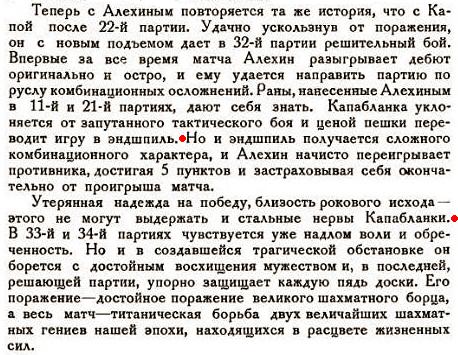
The marked passage, concerning the 32nd match-game, is given below in an English translation by Dan Scoones (Victoria, BC, Canada):
‘However, the endgame also proved to be of a complicated, combinational character, and Alekhine completely outplayed his opponent, attaining the score of five points and conclusively insuring himself against the loss of the match.
Even Capablanca’s nerves of steel could not withstand the vanished hope of victory and the proximity of a fatal result.’
(7442)
Eduardo Bauzá Mercére (New York, NY, USA) has forwarded some photographs which he took on 30 January 2019 at the Club Argentino de Ajedrez, Paraguay 1858, Ciudad Autónoma de Buenos Aires, 1120, Argentina. In the shot below, the Club’s display of the board and pieces used for the 1927 world championship match is intended to show the final position in the decisive 34th match-game, after 82 Re7:
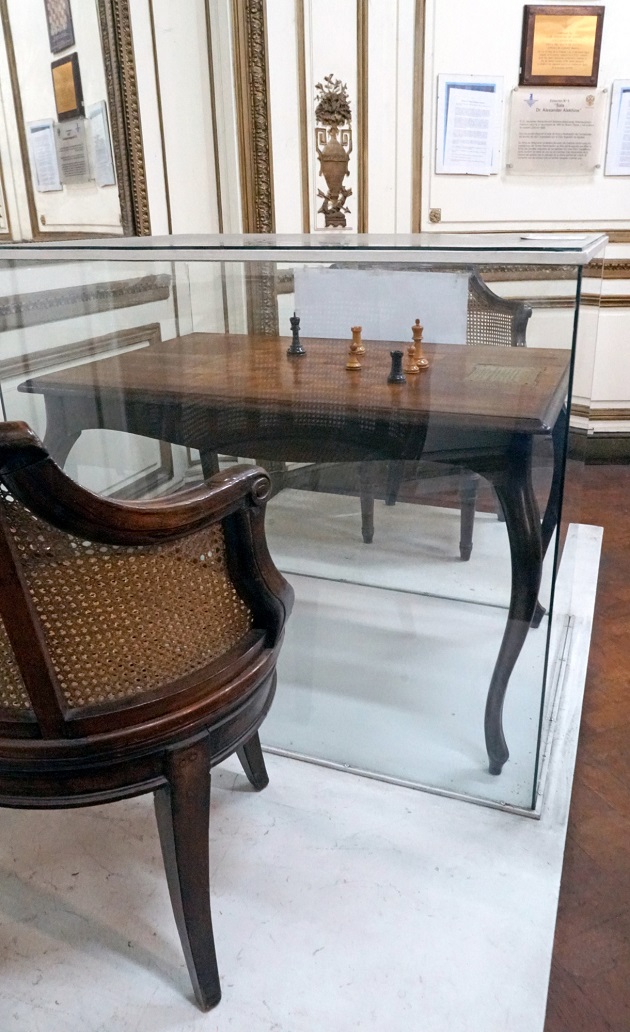
Mr Bauzá Mercére notes that the black rook is on h2, and not h1 as in the game.
We add page 4 of the Argentine newspaper Crítica, 29 November 1927:
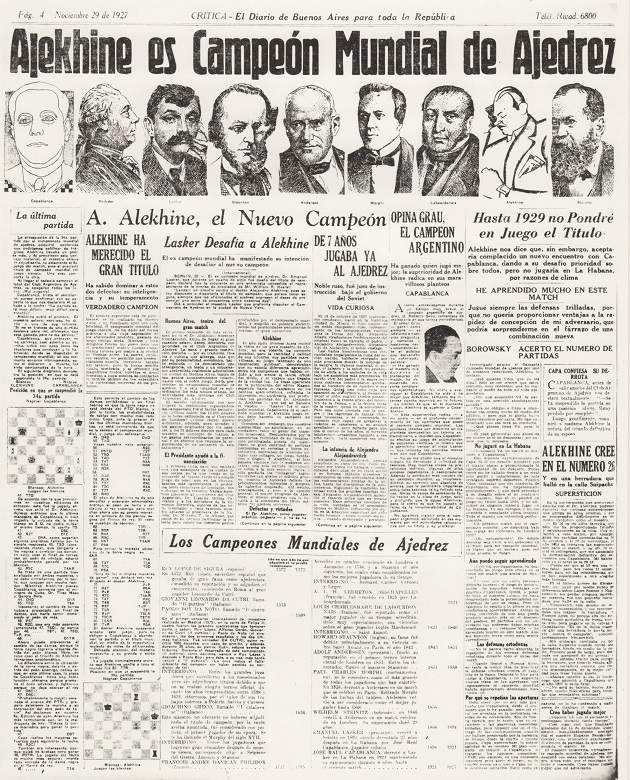
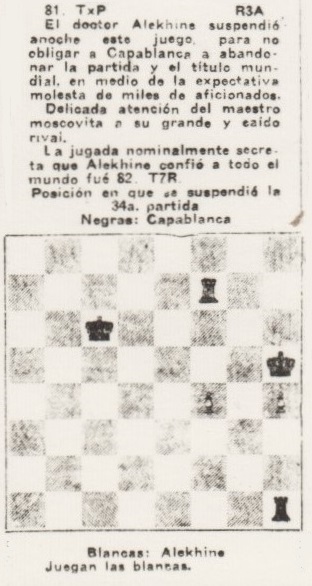
(11219)
Eduardo Bauzá Mercére provides some further photographs taken by him at the Club Argentino de Ajedrez, Buenos Aires, on 25 March 2019:
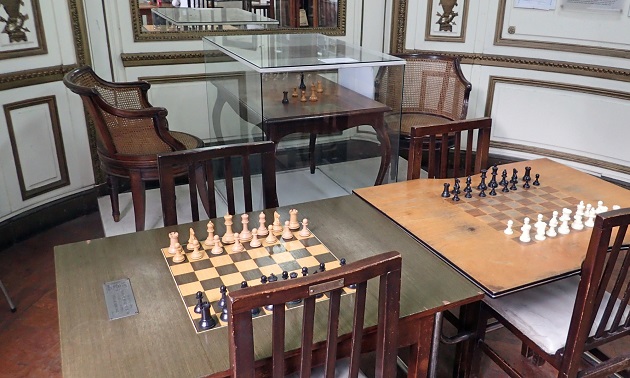
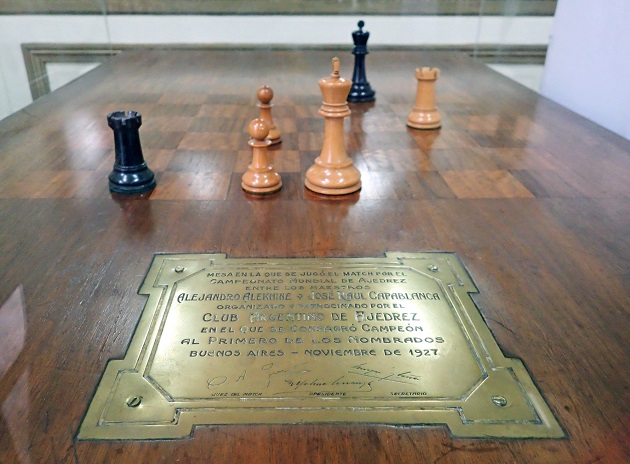
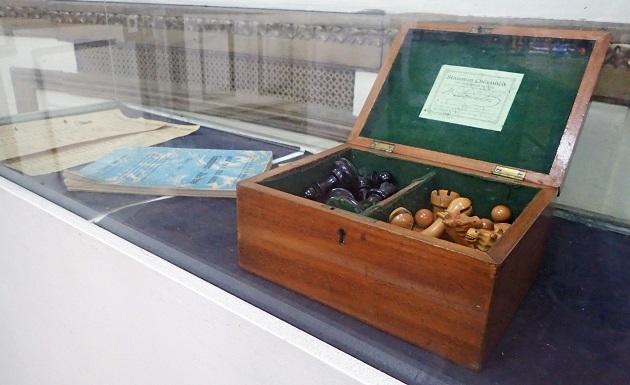
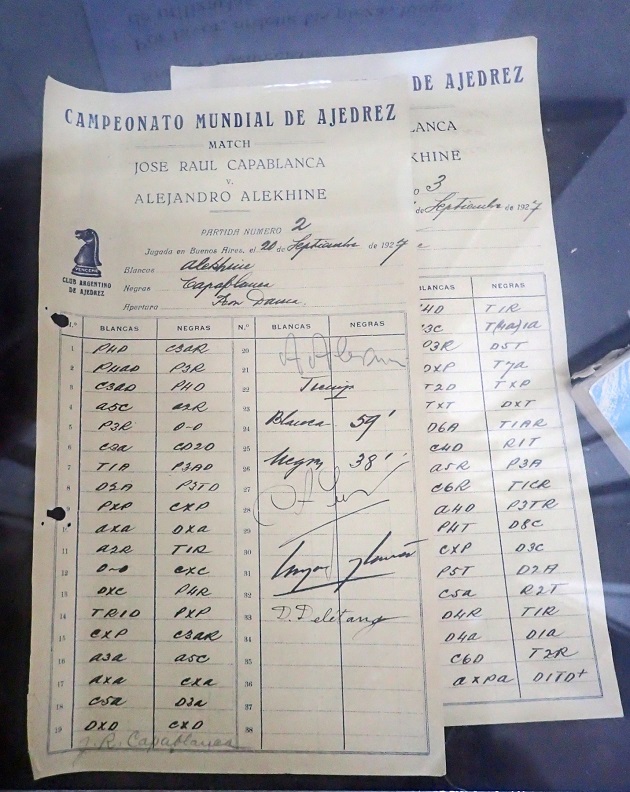
(11278)
Carlos León Cranbourne (Buenos Aires) has provided a set of photographs relating to Capablanca and Alekhine and including their 1927 world title match:
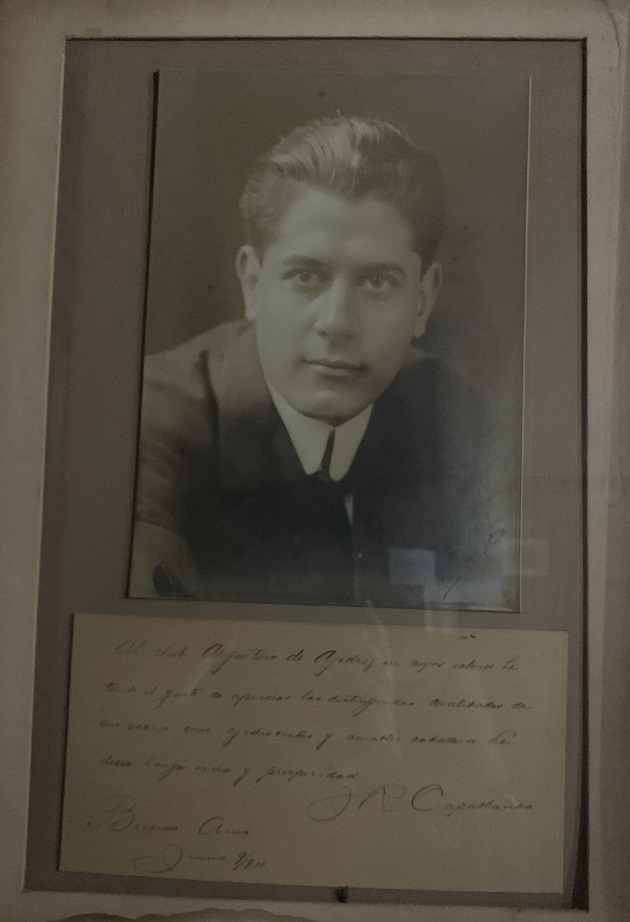
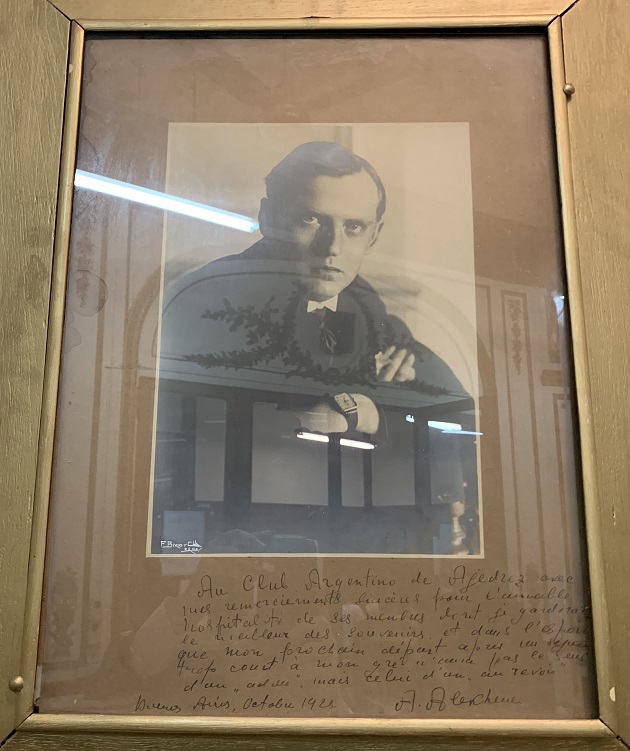
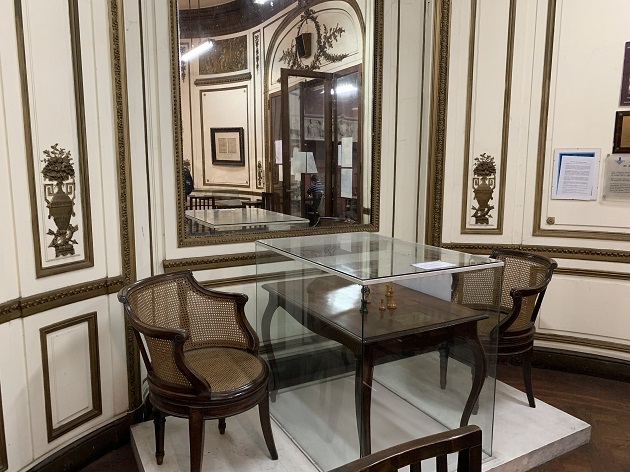
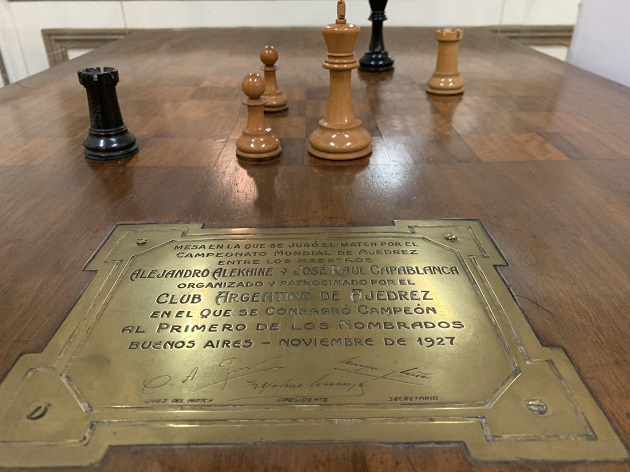
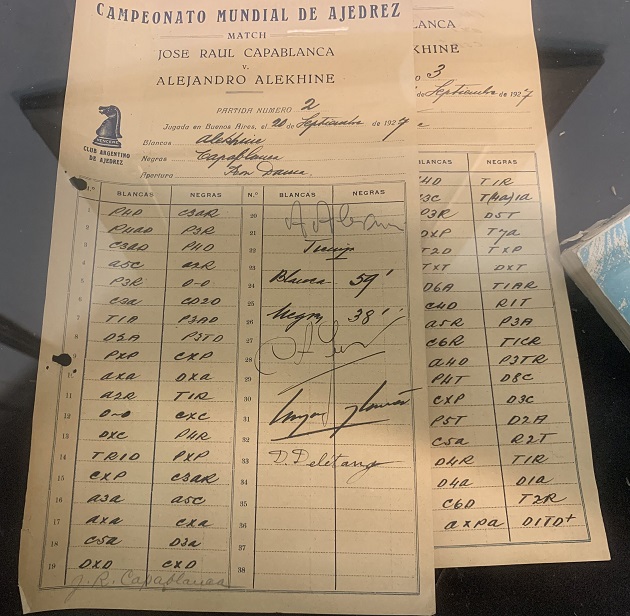
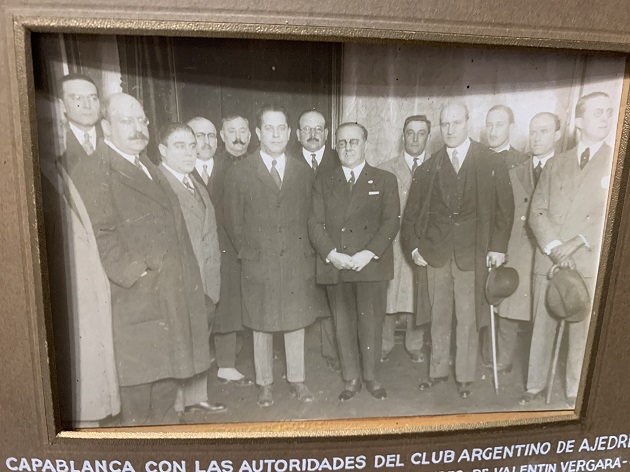
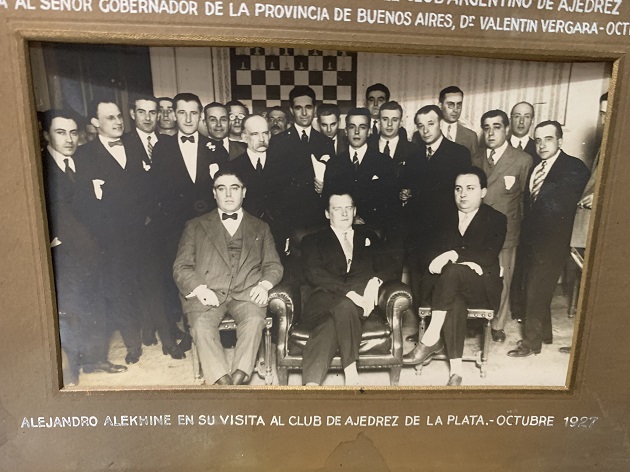
(11349)
Further photographs provided to us by Carlos León Cranbourne:
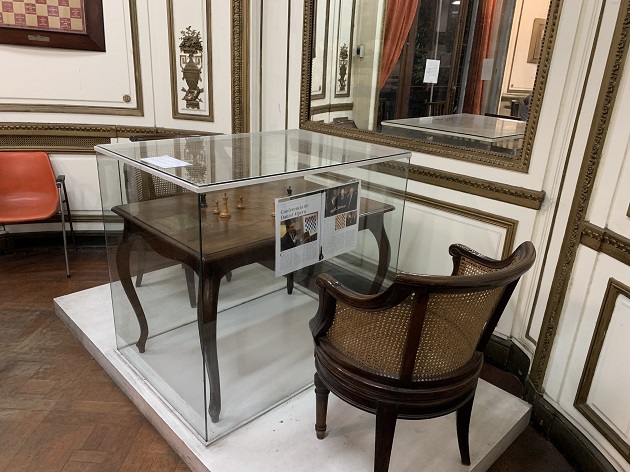
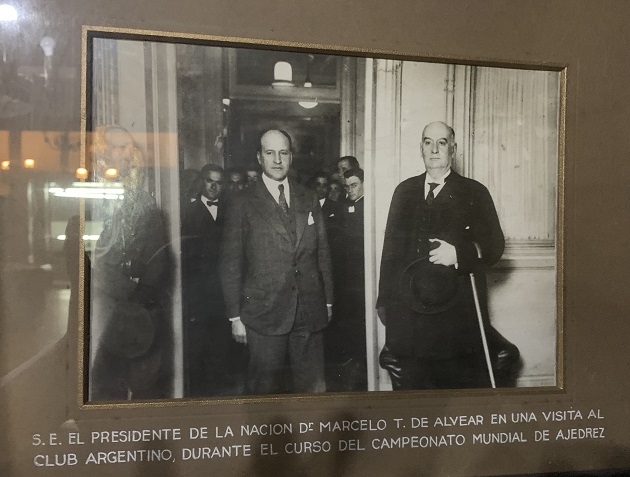
(12003)
The final picture is notable: a visit to the 1927 match by the President of Argentina, Marcelo Torcuato de Alvear (1868-1942).
To the Chess Notes main page.
To the Archives for other feature articles.
Copyright: Edward Winter. All rights reserved.